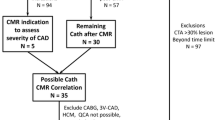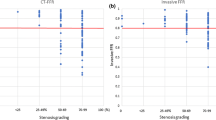Abstract
Objectives
We applied a fully automated pixel-wise post-processing framework to evaluate fully quantitative cardiovascular magnetic resonance myocardial perfusion imaging (CMR-MPI). In addition, we aimed to evaluate the additive value of coronary magnetic resonance angiography (CMRA) to the diagnostic performance of fully automated pixel-wise quantitative CMR-MPI for detecting hemodynamically significant coronary artery disease (CAD).
Methods
A total of 109 patients with suspected CAD were prospectively enrolled and underwent stress and rest CMR-MPI, CMRA, invasive coronary angiography (ICA), and fractional flow reserve (FFR). CMRA was acquired between stress and rest CMR-MPI acquisition, without any additional contrast agent. Finally, CMR-MPI quantification was analyzed by a fully automated pixel-wise post-processing framework.
Results
Of the 109 patients, 42 patients had hemodynamically significant CAD (FFR ≤ 0.80 or luminal stenosis ≥ 90% on ICA) and 67 patients had hemodynamically non-significant CAD (FFR ˃ 0.80 or luminal stenosis < 30% on ICA) were enrolled. On the per-territory analysis, patients with hemodynamically significant CAD had higher myocardial blood flow (MBF) at rest, lower MBF under stress, and lower myocardial perfusion reserve (MPR) than patients with hemodynamically non-significant CAD (p < 0.001). The area under the receiver operating characteristic curve of MPR (0.93) was significantly larger than those of stress and rest MBF, visual assessment of CMR-MPI, and CMRA (p < 0.05), but similar to that of the integration of CMR-MPI with CMRA (0.90).
Conclusions
Fully automated pixel-wise quantitative CMR-MPI can accurately detect hemodynamically significant CAD, but the integration of CMRA obtained between stress and rest CMR-MPI acquisition did not provide significantly additive value.
Key Points
• Full quantification of stress and rest cardiovascular magnetic resonance myocardial perfusion imaging can be postprocessed fully automatically, generating pixel-wise myocardial blood flow (MBF) and myocardial perfusion reserve (MPR) maps.
• Fully quantitative MPR provided higher diagnostic performance for detecting hemodynamically significant coronary artery disease, compared with stress and rest MBF, qualitative assessment, and coronary magnetic resonance angiography (CMRA).
• The integration of CMRA and MPR did not significantly improve the diagnostic performance of MPR alone.






Similar content being viewed by others
Abbreviations
- CAD:
-
Coronary artery disease
- CMD:
-
Coronary microvascular dysfunction
- CMRA:
-
Coronary magnetic resonance angiography
- CMR-MPI:
-
Cardiovascular magnetic resonance myocardial perfusion imaging
- FFR:
-
Fractional flow reserve
- ICA:
-
Invasive coronary angiography
- MBF:
-
Myocardial blood flow
- MPR:
-
Myocardial perfusion reserve
References
Tonino PA, De Bruyne B, Pijls NH et al (2009) Fractional flow reserve versus angiography for guiding percutaneous coronary intervention. N Engl J Med 360:213–224
Nagel E, Greenwood JP, McCann GP et al (2019) Magnetic resonance perfusion or fractional flow reserve in coronary disease. N Engl J Med 380:2418–2428
Takx RA, Blomberg BA, El Aidi H et al (2015) Diagnostic accuracy of stress myocardial perfusion imaging compared to invasive coronary angiography with fractional flow reserve meta-analysis. Circ Cardiovasc Imaging 8:e002666
Hsu LY, Jacobs M, Benovoy M et al (2018) Diagnostic performance of fully automated pixel-wise quantitative myocardial perfusion imaging by cardiovascular magnetic resonance. JACC Cardiovasc Imaging 11:697–707
Bradley AJ, Groves DW, Benovoy M et al (2021) Three automated quantitative cardiac magnetic resonance perfusion analyses versus invasive fractional flow reserve in swine. JACC Cardiovasc Imaging 14:1871–1873
Patel AR, Salerno M, Kwong RY, Singh A, Heydari B, Kramer CM (2021) Stress cardiac magnetic resonance myocardial perfusion imaging: JACC review topic of the week. J Am Coll Cardiol 78:1655–1668
Patel AR, Antkowiak PF, Nandalur KR et al (2010) Assessment of advanced coronary artery disease: advantages of quantitative cardiac magnetic resonance perfusion analysis. J Am Coll Cardiol 56:561–569
Kotecha T, Martinez-Naharro A, Boldrini M et al (2019) Automated pixel-wise quantitative myocardial perfusion map** by CMR to detect obstructive coronary artery disease and coronary microvascular dysfunction: validation against invasive coronary physiology. JACC Cardiovasc Imaging 12:1958–1969
Mangla A, Oliveros E, Williams KA Sr, Kalra DK (2017) Cardiac imaging in the diagnosis of coronary artery disease. Curr Probl Cardiol 42:316–366
Hajhosseiny R, Bustin A, Munoz C et al (2020) Coronary magnetic resonance angiography: technical innovations leading us to the promised land? JACC Cardiovasc Imaging 13:2653–2672
Nazir MS, Bustin A, Hajhosseiny R et al (2022) High-resolution non-contrast free-breathing coronary cardiovascular magnetic resonance ngiography for detection of coronary artery disease: validation against invasive coronary angiography. J Cardiovasc Magn Reson 24:26
Hajhosseiny R, Rashid I, Bustin A et al (2021) Clinical comparison of sub-mm high-resolution non-contrast coronary CMR angiography against coronary CT angiography in patients with low-intermediate risk of coronary artery disease: a single center trial. J Cardiovasc Magn Reson 23:57
Kato S, Kitagawa K, Ishida N et al (2010) Assessment of coronary artery disease using magnetic resonance coronary angiography: a national multicenter trial. J Am Coll Cardiol 56:983–991
Bettencourt N, Ferreira N, Chiribiri A et al (2013) Additive value of magnetic resonance coronary angiography in a comprehensive cardiac magnetic resonance stress-rest protocol for detection of functionally significant coronary artery disease: a pilot study. Circ Cardiovasc Imaging 6:730–738
Zhang L, Song X, Dong L et al (2018) Additive value of 3T cardiovascular magnetic resonance coronary angiography for detecting coronary artery disease. J Cardiovasc Magn Reson 20:29
Kramer CM, Barkhausen J, Bucciarelli-Ducci C, Flamm SD, Kim RJ, Nagel E (2020) Standardized cardiovascular magnetic resonance imaging (CMR) protocols: 2020 update. J Cardiovasc Magn Reson 22:17
Cerqueira MD, Weissman NJ, Dilsizian V et al (2002) Standardized myocardial segmentation and nomenclature for tomographic imaging of the heart. A statement for healthcare professionals from the Cardiac Imaging Committee of the Council on Clinical Cardiology of the American Heart Association. Circulation 105:539–542
Hussain ST, Paul M, Plein S et al (2012) Design and rationale of the MR-INFORM study: stress perfusion cardiovascular magnetic resonance imaging to guide the management of patients with stable coronary artery disease. J Cardiovasc Magn Reson 14:65
Austen WG, Edwards JE, Frye RL et al (1975) A reporting system on patients evaluated for coronary artery disease. Report of the Ad Hoc Committee for Grading of Coronary Artery Disease, Council on Cardiovascular Surgery, American Heart Association. Circulation 51:5–40
Biglands JD, Magee DR, Sourbron SP, Plein S, Greenwood JP, Radjenovic A (2015) Comparison of the diagnostic performance of four quantitative myocardial perfusion estimation methods used in cardiac MR imaging: CE-MARC substudy. Radiology 275:393–402
Lockie T, Ishida M, Perera D et al (2011) High-resolution magnetic resonance myocardial perfusion imaging at 3.0-Tesla to detect hemodynamically significant coronary stenoses as determined by fractional flow reserve. J Am Coll Cardiol 57:70–75
Rahman H, Scannell CM, Demir OM et al (2021) High-resolution cardiac magnetic resonance imaging techniques for the identification of coronary microvascular dysfunction. JACC Cardiovasc Imaging 14:978–986
Franks R, Plein S, Chiribiri A (2021) Clinical application of dynamic contrast enhanced perfusion imaging by cardiovascular magnetic resonance. Front Cardiovasc Med 8:768563
Cheng AS, Pegg TJ, Karamitsos TD et al (2007) Cardiovascular magnetic resonance perfusion imaging at 3-tesla for the detection of coronary artery disease: a comparison with 1.5-tesla. J Am Coll Cardiol 49:2440–2449
Rahman H, Demir OM, Khan F et al (2020) Physiological stratification of patients with angina due to coronary microvascular dysfunction. J Am Coll Cardiol 75:2538–2549
Rahman H, Ryan M, Lumley M et al (2019) Coronary microvascular dysfunction is associated with myocardial ischemia and abnormal coronary perfusion during exercise. Circulation 140:1805–1816
Klocke FJ (1987) Measurements of coronary flow reserve: defining pathophysiology versus making decisions about patient care. Circulation 76:1183–1189
Sakuma H, Ishida M (2022) Advances in myocardial perfusion MR imaging: physiological implications, the importance of quantitative analysis, and impact on patient care in coronary artery disease. Magn Reson Med Sci 21:195–211
Watkins S, McGeoch R, Lyne J et al (2009) Validation of magnetic resonance myocardial perfusion imaging with fractional flow reserve for the detection of significant coronary heart disease. Circulation 120:2207–2213
Bi X, Deshpande V, Simonetti O, Laub G, Li D (2005) Three-dimensional breathhold SSFP coronary MRA: a comparison between 1.5T and 3.0T. J Magn Reson Imaging 22:206–212
Bastiaansen JAM, van Heeswijk RB, Stuber M, Piccini D (2019) Noncontrast free-breathing respiratory self-navigated coronary artery cardiovascular magnetic resonance angiography at 3 T using lipid insensitive binomial off-resonant excitation (LIBRE). J Cardiovasc Magn Reson 21:38
Coristine AJ, van Heeswijk RB, Stuber M (2014) Fat signal suppression for coronary MRA at 3T using a water-selective adiabatic T2 -preparation technique. Magn Reson Med 72:763–769
Kato Y, Ambale-Venkatesh B, Kassai Y et al (2020) Non-contrast coronary magnetic resonance angiography: current frontiers and future horizons. MAGMA 33:591–612
Zhao SH, Li CG, Chen YY, Yun H, Zeng MS, ** H (2020) Applying nitroglycerin at coronary MR angiography at 1.5 T: diagnostic performance of coronary vasodilation in patients with coronary artery disease. Radiol Cardiothorac Imaging 2:e190018
Funding
This study has received funding from the Shanghai Science and Technology Committee (grant number: 18DZ1930102), the Shanghai Municipal Key Clinical Specialty (grant number: shslczdzk03202), the Science Foundation of Shanghai Municipal Health Commission (grant numbers: 202140291 and 202040349), and the Shanghai Pujiang Program (grant number: 21PJD012).
Author information
Authors and Affiliations
Corresponding authors
Ethics declarations
Guarantor
The scientific guarantor of this publication is Meng-su Zeng, MD, PhD.
Conflict of interest
Two authors (**ao-yue Zhou, Cai-xia Fu) are employees of Siemens. The remaining authors declare no relationships with any companies whose products or services may be related to the subject matter of the article.
Statistics and biometry
No complex statistical methods were necessary for this paper.
Informed consent
Written informed consent was obtained from all subjects (patients) in this study.
Ethical approval
Institutional Review Board approval was obtained.
Study subjects or cohorts overlap
No study subjects or cohorts have been previously reported.
Methodology
• Prospective
• Diagnostic study
• performed at one institution
Additional information
Publisher's note
Springer Nature remains neutral with regard to jurisdictional claims in published maps and institutional affiliations.
Rights and permissions
Springer Nature or its licensor (e.g. a society or other partner) holds exclusive rights to this article under a publishing agreement with the author(s) or other rightsholder(s); author self-archiving of the accepted manuscript version of this article is solely governed by the terms of such publishing agreement and applicable law.
About this article
Cite this article
Zhao, Sh., Guo, Wf., Yao, Zf. et al. Fully automated pixel-wise quantitative CMR-myocardial perfusion with CMR-coronary angiography to detect hemodynamically significant coronary artery disease. Eur Radiol 33, 7238–7249 (2023). https://doi.org/10.1007/s00330-023-09689-8
Received:
Revised:
Accepted:
Published:
Issue Date:
DOI: https://doi.org/10.1007/s00330-023-09689-8




